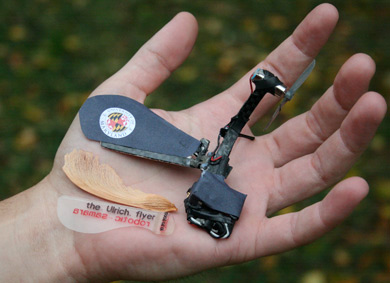Micro-vehicle Imitates the Winged Maple Seed
Growing up, I used to toss up Maple seeds and watch as these “helicopters” slowly spiraled to the ground.

Now a team at the University of Maryland’s Clark School of Engineering has created a small, one-winged, remote-controlled device that mimics the maple seed’s graceful flight mechanics
Researchers have aimed to make micro air vehicles for some time, often taking inspiration from nature, such as dragonflies or houseflies, to design small, efficient devices. Such low-powered micro vehicles could be used in surveillance, search-and-rescue, and communications applications.
The new “robo-seed” can fly and hover stably using just its single twisting propeller. The researchers accomplished this by separating the carefully-shaped wing and body components of the device, allowing them to control the wing’s tilt (and the size of the helix-shaped descent) without throwing off the flyer’s balance.
According to the university’s press release, the robo-seed can not only take off from the ground and hover in air, but it can also perform controlled flight and hover when tossed from an aircraft or by hand.
Watch a video charting the robo-seed’s development below.
Keep Reading
Most Popular
Large language models can do jaw-dropping things. But nobody knows exactly why.
And that's a problem. Figuring it out is one of the biggest scientific puzzles of our time and a crucial step towards controlling more powerful future models.
The problem with plug-in hybrids? Their drivers.
Plug-in hybrids are often sold as a transition to EVs, but new data from Europe shows we’re still underestimating the emissions they produce.
Google DeepMind’s new generative model makes Super Mario–like games from scratch
Genie learns how to control games by watching hours and hours of video. It could help train next-gen robots too.
How scientists traced a mysterious covid case back to six toilets
When wastewater surveillance turns into a hunt for a single infected individual, the ethics get tricky.
Stay connected
Get the latest updates from
MIT Technology Review
Discover special offers, top stories, upcoming events, and more.